New Delhi Aikido Dojo is happy to announce that we are Organizing our next Exclusive Aikido Seminar from the 6th to the 8th of November, 2015.
A group of about ten senior Aikido practitioners from Capital Aikikai, USA, headed by Clyde Takeguchi Shihan will visit India from 4-16 November.Takeguchi sensei has gracefully agreed to conduct a seminar at New Delhi Aikido Dojo during this visit. The Seminar will be conducted by Shihan Clyde Takeguchi Sensei,7th Dan, and Shihan Bill Plank Sensei,6th Dan.
This is a unique opportunity to be a part of this great event by attending this seminar. Kindly make your time to attend this special seminar which can help you to purify your techniques.
On the last day we will be organizing a farewell Dinner for the visitors as well as for the local participants.
Schedule:
Friday, November 6:
Evening:
6:30 – 7:30 – Takeguchi Sensei
7:40 – 8:40 – Plank Sensei
Saturday, November 7:
Morning:
9:00 – 10:00 – Takeguchi Sensei
10:10 – 11:10 – Plank Sensei
11:20 – 12:30 Takeguchi Sensei
Evening:
6:30 – 7:30 – Plank Sensei
7:40 – 8:40 – Takeguchi Sensei
Sunday, November 8:
Morning:
9:00 – 10:00 – Plank Sensei
10:10 – 11:10 – Takeguchi Sensei
11:20 – 12:20 – Plank Sensei
12:30 – 1:30 – Takeguchi Sensei
A simple lunch will be provided by the dojo.
No evening class on Sunday
NB: Classes on 5th evening and 6th morning will be taken by Sarah Guroff and Paritos Kar respectively.
Farewell Dinner: 8 pm at NDMC Club
All those who are interested to participate may please contact Sensei Paritos Kar on +91 9899822332











